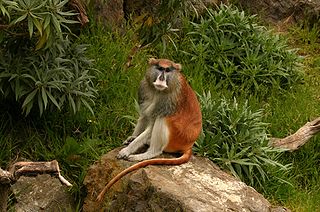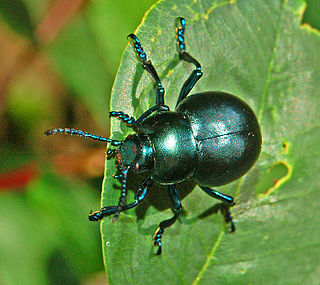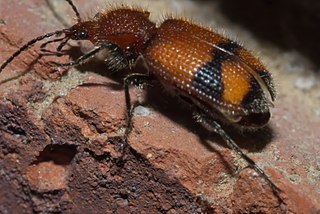
Tetraodontiformes, also known as the Plectognathi, is an order of ray-finned fishes which includes the pufferfishes and related taxa. This order has been classified as a suborder of the order Perciformes, although recent studies have found that it, as the Tetraodontoidei, is a sister taxon to the anglerfish order Lophiiformes, called Lophiodei, and have placed both taxa within the Acanthuriformes. The Tetraodontiformes are represented by 10 extant families and at around 430 species overall. The majority of the species within this order are marine but a few may be found in freshwater. They are found throughout the world.

Genus is a taxonomic rank above species and below family as used in the biological classification of living and fossil organisms as well as viruses. In binomial nomenclature, the genus name forms the first part of the binomial species name for each species within the genus.

Musaceae is a family of flowering plants composed of three genera with about 91 known species, placed in the order Zingiberales. The family is native to the tropics of Africa and Asia. The plants have a large herbaceous growth habit with leaves with overlapping basal sheaths that form a pseudostem making some members appear to be woody trees. In most treatments, the family has three genera, Musa, Musella and Ensete. Cultivated bananas are commercially important members of the family, and many others are grown as ornamental plants.

Carcharhiniformes, the Requiem sharks, are the largest order of sharks, with over 270 species. They include a number of common types, such as catsharks, swellsharks, and requiem sharks.

Erythrocebus is a genus of Old World monkey. All three species in this genus are found in Africa, and are known as patas monkeys. While previously considered a monotypic genus containing just E. patas, a 2017 review argued that, based on morphological evidence and heavy geographic separation between taxa, E. patas should be split back into distinct species as recognised in the 19th century.

Neofelis is a genus comprising two extant cat species in Southeast Asia: the clouded leopard of mainland Asia, and the Sunda clouded leopard of Sumatra and Borneo.

Violaceae is a family of flowering plants established in 1802, consisting of about 1000 species in about 25 genera. It takes its name from the genus Viola, the violets and pansies.

The Pterophoridae or plume moths are a family of Lepidoptera with unusually modified wings, giving them the shape of a narrow winged airplane. Though they belong to the Apoditrysia like the larger moths and the butterflies, unlike these they are tiny and were formerly included among the assemblage called "microlepidoptera".

Bonitos are a tribe of medium-sized, ray-finned predatory fish in the family Scombridae – a family it shares with the mackerel, tuna, and Spanish mackerel tribes, and also the butterfly kingfish. Also called the tribe Sardini, it consists of eight species across four genera; three of those four genera are monotypic, having a single species each. Bonitos closely resemble the skipjack tuna, which is often called a bonito, especially in Japanese contexts.

The Carangidae are a family of ray-finned fish that includes the jacks, pompanos, jack mackerels, runners, trevallies, and scads. It is the largest of the six families included within the order Carangiformes. Some authorities classify it as the only family within that order but molecular and anatomical studies indicate that there is a close relationship between this family and the five former Perciform families which make up the Carangiformes.

The Gempylidae are a family of scombriform ray-finned fishes commonly known as snake mackerels or escolars. The family includes about 25 species.

Timarcha is a genus of leaf beetles in the family Chrysomelidae, with more than 100 described species in three subgenera. The most widely known species is T. tenebricosa, the bloody-nosed beetle. All species are black, wingless organisms. Timarcha are herbivorous species, living mostly on plants belonging to Rubiaceae and Plumbaginaceae, although a few can feed on Brassicaceae and Rosaceae. Timarcha is the only member of the tribe Timarchini.

Juliidae, common name the bivalved gastropods, is a family of minute sea snails, marine gastropod mollusks or micromollusks in the superfamily Oxynooidea, an opisthobranch group.

Badister is a genus of ground beetle in the family Carabidae native to North Africa, the Near East, and the Holarctic, including Europe.

Panagaeus is a genus in the beetle family Carabidae, native to the Holarctic, the Near East, and North Africa, as well as Central and South America. There are about 15 described species in Panagaeus.

Synuchus is a genus in the beetle family Carabidae. There are more than 80 described species in Synuchus.
Eucaerus is a genus of ground beetles in the family Carabidae. There are about seven described species in Eucaerus, found in North, Central, and South America.
Lachnothorax is a genus in the beetle family Carabidae. There are about eight described species in Lachnothorax.
Aphaenops is a genus of beetles in the family Carabidae, containing the following species: All species in the genus are obligate troglobites, and each species is usually endemic to a single cave system; they are unpigmented, and have no functional eyes.

Cephea is a genus of true jellyfish in the family Cepheidae. They are found in the Indo-Pacific and eastern Atlantic oceans. They are sometimes called the crown jellyfish, but this can cause confusion with the closely related genus Netrostoma or the distantly related species in the order Coronatae. They are also sometimes called the cauliflower jellyfish because of the cauliflower-looking form on top of its bell.

















